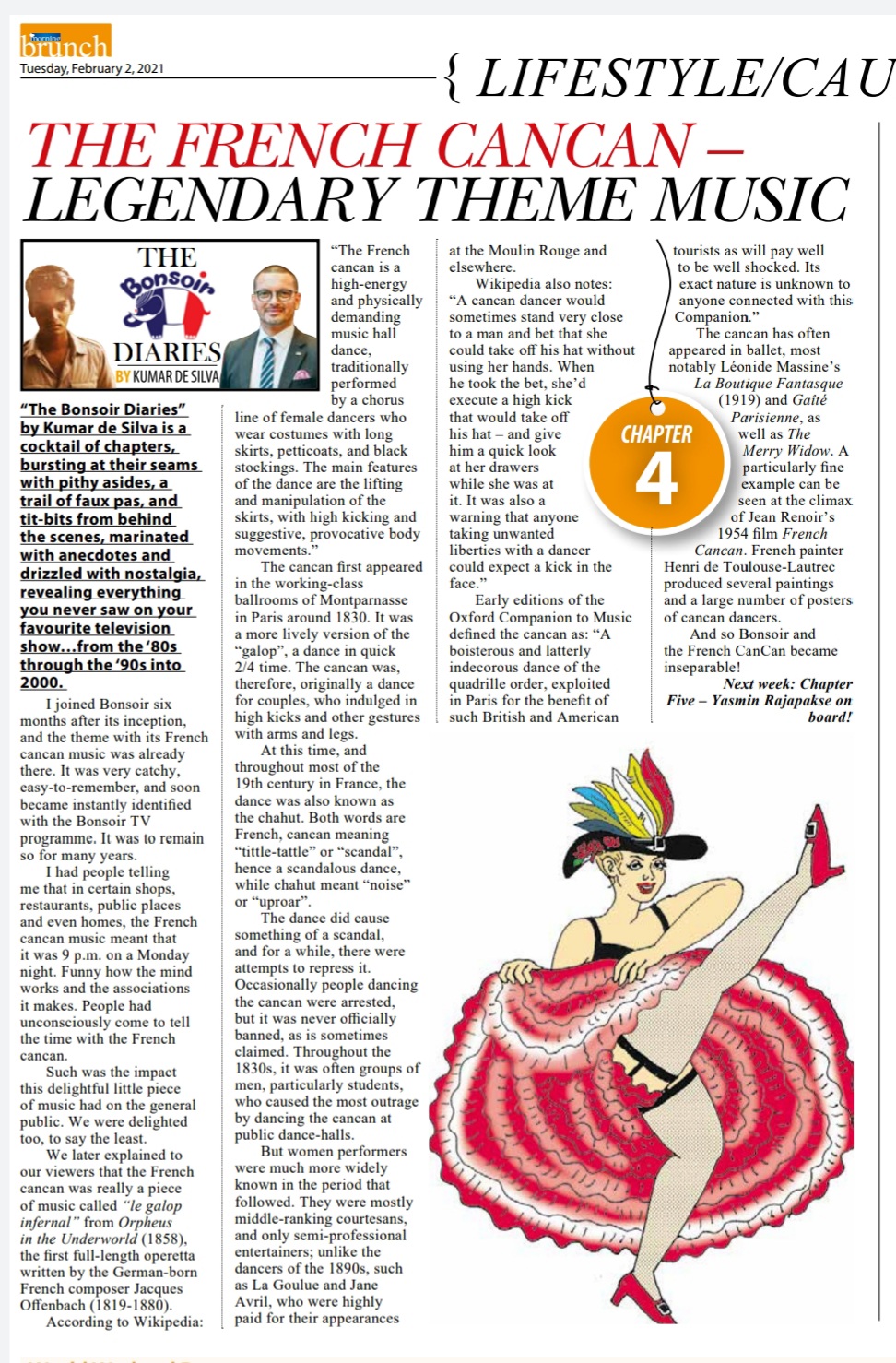THE BONSOIR DIARIES – Chapter 04 – The French Cancan … legendary theme music

This year I celebrate 35 years on ‘Bonsoir’ and on Sri Lankan television. Bonsoir closed down in 2010 and in the absence of an archives is ‘Bonsoir Diaries’, the behind-the-scenes stories I wrote in 2013.
The book is a cocktail of chapters, bursting at their seams with pithy asides, a trail of faux-pas, tit-bits from behind-the-scenes marinated with anecdotes and drizzled with nostalgia, revealing everything you never saw on your favourite television show … from the 80s through the 90s into 2000.
In celebration of my 35 years on ‘Bonsoir’ and Sri Lankan television this year, ‘The Morning’ newspaper serialises the fifty chapters of the (now sold out) ‘Bonsoir Diaries’ every Tuesday.
CLICK HERE TO READ – http://www.themorning.lk/chapter-04-the-french-cancan-legendary-theme-music/
50 chapters over 50 weeks will take us right upto Christmas 2021. Happy Reading !!!
THE BONSOIR DIARIES – Chapter 04 – The French Cancan … legendary theme music
I joined Bonsoir six months after its inception and the theme with its French cancan music was already there. It was very catchy, easy-to-remember and soon became instantly identified with the Bonsoir TV programme. It was to remain so for many years.
I had people telling me that in certain shops, restaurants, public places and even homes, the French cancan music meant that it was 9.00 pm on a Monday night. Funny how the mind works and the associations it makes. People had unconsciously come to tell the time with the French cancan. Such was the impact this delightful little piece of music had on the general public. We were delighted too, to say the least.

We later explained to our viewers that the French cancan was really a piece of music called ‘le galop infernal’ from Orpheus in the Underworld (1858) the first full-length operetta written by the German-born French composer Jacques Offenbach (1819-1880).
According to Wikipedia ……….
The French cancan is a high-energy and physically demanding music hall dance, traditionally performed by a chorus line of female dancers who wear costumes with long skirts, petticoats, and black stockings. The main features of the dance are the lifting and manipulation of the skirts, with high kicking and suggestive, provocative body movements.

The cancan first appeared in the working-class ballrooms of Montparnasse in Paris in around 1830. It was a more lively version of the ‘galop’, a dance in quick 2/4 time. The cancan was, therefore, originally a dance for couples, who indulged in high kicks and other gestures with arms and legs.
At this time, and throughout most of the 19th century in France, the dance was also known as the chahut. Both words are French, cancan meaning “tittle-tattle” or “scandal”, hence a scandalous dance, while chahut meant “noise” or “uproar”.
The dance did cause something of a scandal, and for a while, there were attempts to repress it. Occasionally people dancing the cancan were arrested but it was never officially banned, as is sometimes claimed.
Throughout the 1830s, it was often groups of men, particularly students, who caused the most outrage by dancing the cancan at public dance-halls.
But women performers were much more widely known in the period that followed. They were mostly middle-ranking courtesans, and only semi-professional entertainers – unlike the dancers of the 1890s, such as La Goulue and Jane Avril, who were highly paid for their appearances at the Moulin Rouge and elsewhere.
It was the choreographer Pierre Sandrini who presented the spectacular “French Cancan”, which he devised at the Moulin Rouge in the 1920s and presented at his own Bal Tabarin from 1928.
This was a combination of the individual style of the Parisian dance-halls and the chorus-line style of British and American music halls.
In the United Kingdom, the United States and elsewhere, the cancan achieved popularity in music halls, where it was danced by groups of women in choreographed routines.
This style was imported into France in the 1920s for the benefit of tourists, and the French Cancan was born—a highly choreographed routine lasting ten minutes or more, with the opportunity for individuals to display their “specialties”.

The main moves are the high kick or battement, the rond de jambe (quick rotary movement of lower leg with knee raised and skirt held up), the port d’armes (turning on one leg, while grasping the other leg by the ankle and holding it almost vertical), the cartwheel and the grand écart (the flying or jump splits).
It has become common practice for dancers to scream and yelp while performing the cancan, but this is by no means essential.
The cancan is now considered a part of world dance culture and it still retains something of an erotic connotation for many. When the dance first appeared in the early 19th century, it was considered little more than a scandalous activity that young people indulged in.
In the mid-19th century, when the dance was emerging from the working-class dance-halls into the mainstream, it was thought to be extremely inappropriate by “respectable” society.
In the late 19th and early 20th centuries the cancan was viewed as much more erotic because the dancers made use of the extravagant underwear of the period, and the contrasting black stockings.

They lifted and manipulated their skirts much more, and incorporated a move sometimes considered the most cheeky and provocative—bending over and throwing their skirts over their backs, presenting their bottoms to the audience. The Moulin Rouge dancer La Goulue was well known for this gesture, and she had a heart embroidered on the seat of her drawers.
A Cancan dancer would sometimes stand very close to a man and bet that she could take off his hat without using her hands. When he took the bet, she’d execute a high kick that would take off his hat—and give him a quick look at her drawers while she was at it. It was also a warning that anyone taking unwanted liberties with a dancer could expect a kick in the face.
It is a myth that the cancan was ever frequently danced without drawers. Initially drawers were of the “open” type, being essentially two tubes of material, one for each leg, and this is perhaps another reason for the myth. However, the Moulin Rouge management did not permit dancers to perform in such revealing garments.
Early editions of the Oxford Companion to Music defined the cancan as “A boisterous and latterly indecorous dance of the quadrille order, exploited in Paris for the benefit of such British and American tourists as will pay well to be well shocked. Its exact nature is unknown to anyone connected with this Companion.”
The cancan has often appeared in ballet, most notably Léonide Massine’s La Boutique fantasque (1919) and Gaîté Parisienne, as well as The Merry Widow. A particularly fine example can be seen at the climax of Jean Renoir’s 1954 film French Cancan. French painter Henri de Toulouse-Lautrec produced several paintings and a large number of posters of cancan dancers.
……………..… and so Bonsoir and the French CanCan became inseparable !
























